Yunchen Pu
Hierarchical Structured Neural Network for Retrieval
Aug 13, 2024



Abstract:Embedding Based Retrieval (EBR) is a crucial component of the retrieval stage in (Ads) Recommendation System that utilizes Two Tower or Siamese Networks to learn embeddings for both users and items (ads). It then employs an Approximate Nearest Neighbor Search (ANN) to efficiently retrieve the most relevant ads for a specific user. Despite the recent rise to popularity in the industry, they have a couple of limitations. Firstly, Two Tower model architecture uses a single dot product interaction which despite their efficiency fail to capture the data distribution in practice. Secondly, the centroid representation and cluster assignment, which are components of ANN, occur after the training process has been completed. As a result, they do not take into account the optimization criteria used for retrieval model. In this paper, we present Hierarchical Structured Neural Network (HSNN), a deployed jointly optimized hierarchical clustering and neural network model that can take advantage of sophisticated interactions and model architectures that are more common in the ranking stages while maintaining a sub-linear inference cost. We achieve 6.5% improvement in offline evaluation and also demonstrate 1.22% online gains through A/B experiments. HSNN has been successfully deployed into the Ads Recommendation system and is currently handling major portion of the traffic. The paper shares our experience in developing this system, dealing with challenges like freshness, volatility, cold start recommendations, cluster collapse and lessons deploying the model in a large scale retrieval production system.
Continuous-Time Flows for Efficient Inference and Density Estimation
Aug 01, 2018



Abstract:Two fundamental problems in unsupervised learning are efficient inference for latent-variable models and robust density estimation based on large amounts of unlabeled data. Algorithms for the two tasks, such as normalizing flows and generative adversarial networks (GANs), are often developed independently. In this paper, we propose the concept of {\em continuous-time flows} (CTFs), a family of diffusion-based methods that are able to asymptotically approach a target distribution. Distinct from normalizing flows and GANs, CTFs can be adopted to achieve the above two goals in one framework, with theoretical guarantees. Our framework includes distilling knowledge from a CTF for efficient inference, and learning an explicit energy-based distribution with CTFs for density estimation. Both tasks rely on a new technique for distribution matching within amortized learning. Experiments on various tasks demonstrate promising performance of the proposed CTF framework, compared to related techniques.
JointGAN: Multi-Domain Joint Distribution Learning with Generative Adversarial Nets
Jun 08, 2018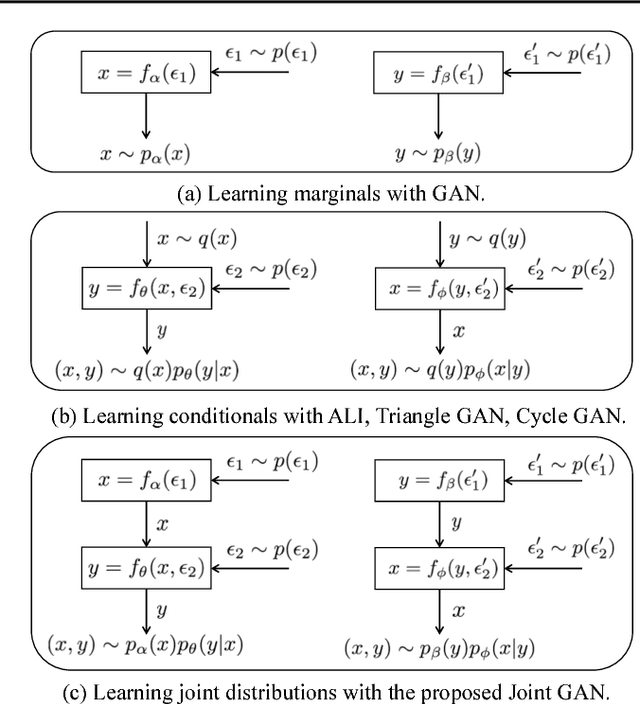
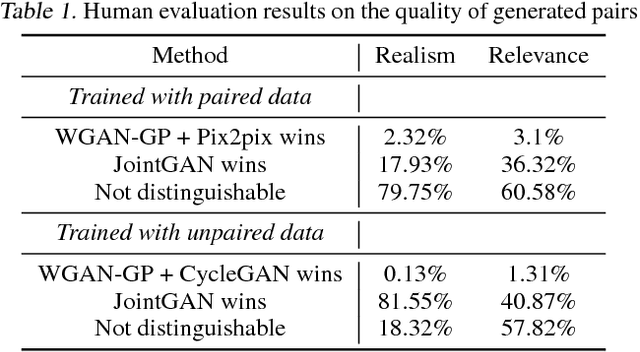
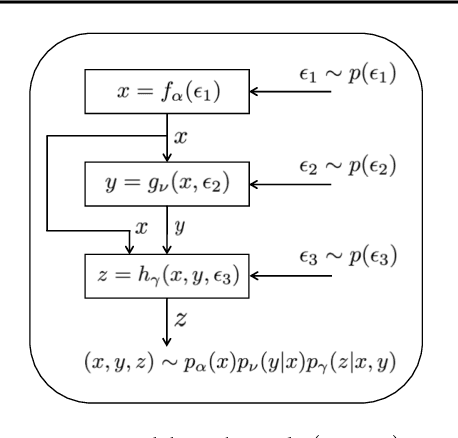

Abstract:A new generative adversarial network is developed for joint distribution matching. Distinct from most existing approaches, that only learn conditional distributions, the proposed model aims to learn a joint distribution of multiple random variables (domains). This is achieved by learning to sample from conditional distributions between the domains, while simultaneously learning to sample from the marginals of each individual domain. The proposed framework consists of multiple generators and a single softmax-based critic, all jointly trained via adversarial learning. From a simple noise source, the proposed framework allows synthesis of draws from the marginals, conditional draws given observations from a subset of random variables, or complete draws from the full joint distribution. Most examples considered are for joint analysis of two domains, with examples for three domains also presented.
Zero-Shot Learning via Class-Conditioned Deep Generative Models
Nov 19, 2017



Abstract:We present a deep generative model for learning to predict classes not seen at training time. Unlike most existing methods for this problem, that represent each class as a point (via a semantic embedding), we represent each seen/unseen class using a class-specific latent-space distribution, conditioned on class attributes. We use these latent-space distributions as a prior for a supervised variational autoencoder (VAE), which also facilitates learning highly discriminative feature representations for the inputs. The entire framework is learned end-to-end using only the seen-class training data. The model infers corresponding attributes of a test image by maximizing the VAE lower bound; the inferred attributes may be linked to labels not seen when training. We further extend our model to a (1) semi-supervised/transductive setting by leveraging unlabeled unseen-class data via an unsupervised learning module, and (2) few-shot learning where we also have a small number of labeled inputs from the unseen classes. We compare our model with several state-of-the-art methods through a comprehensive set of experiments on a variety of benchmark data sets.
Triangle Generative Adversarial Networks
Nov 18, 2017



Abstract:A Triangle Generative Adversarial Network ($\Delta$-GAN) is developed for semi-supervised cross-domain joint distribution matching, where the training data consists of samples from each domain, and supervision of domain correspondence is provided by only a few paired samples. $\Delta$-GAN consists of four neural networks, two generators and two discriminators. The generators are designed to learn the two-way conditional distributions between the two domains, while the discriminators implicitly define a ternary discriminative function, which is trained to distinguish real data pairs and two kinds of fake data pairs. The generators and discriminators are trained together using adversarial learning. Under mild assumptions, in theory the joint distributions characterized by the two generators concentrate to the data distribution. In experiments, three different kinds of domain pairs are considered, image-label, image-image and image-attribute pairs. Experiments on semi-supervised image classification, image-to-image translation and attribute-based image generation demonstrate the superiority of the proposed approach.
Adversarial Symmetric Variational Autoencoder
Nov 18, 2017



Abstract:A new form of variational autoencoder (VAE) is developed, in which the joint distribution of data and codes is considered in two (symmetric) forms: ($i$) from observed data fed through the encoder to yield codes, and ($ii$) from latent codes drawn from a simple prior and propagated through the decoder to manifest data. Lower bounds are learned for marginal log-likelihood fits observed data and latent codes. When learning with the variational bound, one seeks to minimize the symmetric Kullback-Leibler divergence of joint density functions from ($i$) and ($ii$), while simultaneously seeking to maximize the two marginal log-likelihoods. To facilitate learning, a new form of adversarial training is developed. An extensive set of experiments is performed, in which we demonstrate state-of-the-art data reconstruction and generation on several image benchmark datasets.
VAE Learning via Stein Variational Gradient Descent
Nov 17, 2017


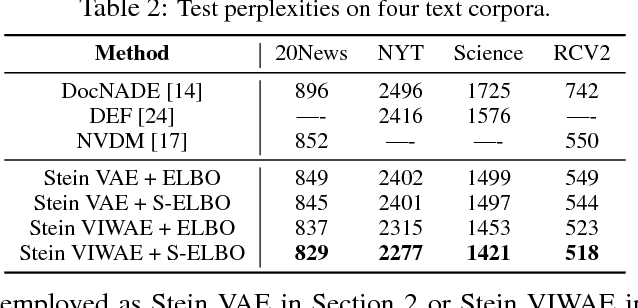
Abstract:A new method for learning variational autoencoders (VAEs) is developed, based on Stein variational gradient descent. A key advantage of this approach is that one need not make parametric assumptions about the form of the encoder distribution. Performance is further enhanced by integrating the proposed encoder with importance sampling. Excellent performance is demonstrated across multiple unsupervised and semi-supervised problems, including semi-supervised analysis of the ImageNet data, demonstrating the scalability of the model to large datasets.
Adaptive Feature Abstraction for Translating Video to Text
Nov 17, 2017



Abstract:Previous models for video captioning often use the output from a specific layer of a Convolutional Neural Network (CNN) as video features. However, the variable context-dependent semantics in the video may make it more appropriate to adaptively select features from the multiple CNN layers. We propose a new approach for generating adaptive spatiotemporal representations of videos for the captioning task. A novel attention mechanism is developed, that adaptively and sequentially focuses on different layers of CNN features (levels of feature "abstraction"), as well as local spatiotemporal regions of the feature maps at each layer. The proposed approach is evaluated on three benchmark datasets: YouTube2Text, M-VAD and MSR-VTT. Along with visualizing the results and how the model works, these experiments quantitatively demonstrate the effectiveness of the proposed adaptive spatiotemporal feature abstraction for translating videos to sentences with rich semantics.
ALICE: Towards Understanding Adversarial Learning for Joint Distribution Matching
Nov 05, 2017



Abstract:We investigate the non-identifiability issues associated with bidirectional adversarial training for joint distribution matching. Within a framework of conditional entropy, we propose both adversarial and non-adversarial approaches to learn desirable matched joint distributions for unsupervised and supervised tasks. We unify a broad family of adversarial models as joint distribution matching problems. Our approach stabilizes learning of unsupervised bidirectional adversarial learning methods. Further, we introduce an extension for semi-supervised learning tasks. Theoretical results are validated in synthetic data and real-world applications.
Symmetric Variational Autoencoder and Connections to Adversarial Learning
Oct 19, 2017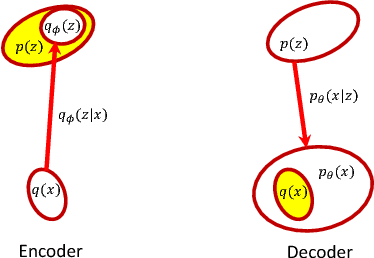
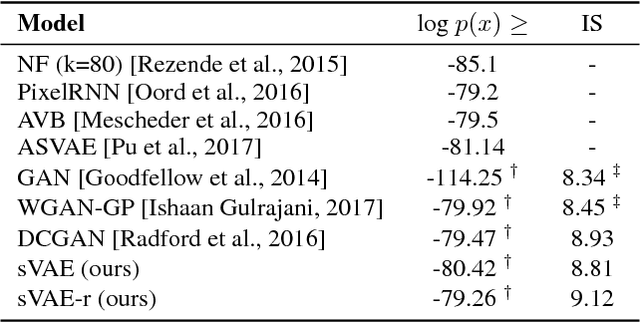
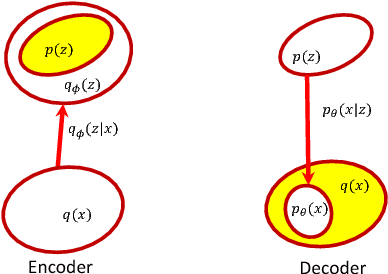
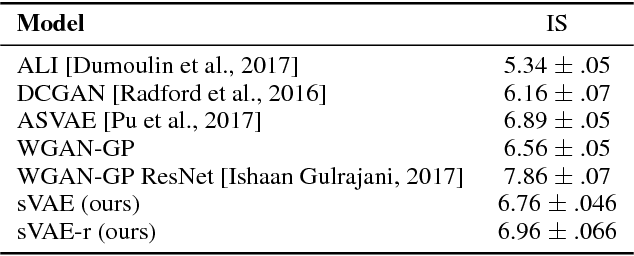
Abstract:A new form of the variational autoencoder (VAE) is proposed, based on the symmetric Kullback-Leibler divergence. It is demonstrated that learning of the resulting symmetric VAE (sVAE) has close connections to previously developed adversarial-learning methods. This relationship helps unify the previously distinct techniques of VAE and adversarially learning, and provides insights that allow us to ameliorate shortcomings with some previously developed adversarial methods. In addition to an analysis that motivates and explains the sVAE, an extensive set of experiments validate the utility of the approach.
 Add to Chrome
Add to Chrome Add to Firefox
Add to Firefox Add to Edge
Add to Edge